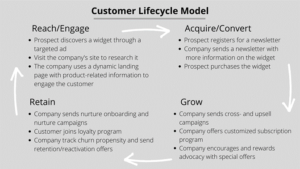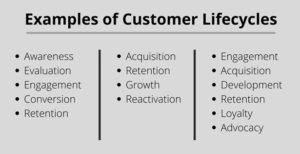Customers today are more unpredictable and demanding than ever before. They want to own their own customer experience, not be led by brands’ directives. So, it may seem impossible to move customers through a pre-planned journey or manage the customer lifecycle. Actually, doing so is essential—because customers also expect personalized experiences. Guiding them through engaging and relevant journeys not only delivers the value they want from brands today, but it also wins their ongoing business and loyalty.
Customer lifecycle management and its partner, customer lifecycle marketing, enable marketers to deliver those relevant customer experiences, interactions and journeys. The first step is to determine what exactly is your organization’s customer lifecycle—the process customers go through as they build a relationship with your brand. Different companies use different terms and stages for the element of the customer lifecycle based on the steps prospects and customers take as they learn about and interact with them.
For many companies the customer lifecycle begins with awareness; for others, it begins with some type of engagement, such as a prospect subscribing to an email newsletter. Generally, the customer lifecycle then continues with acquisition (i.e., a purchase), development (e.g., increased value/wallet share), retention and loyalty. Ideally, it’s a continuous cycle, which is why reengagement is a step in some companies’ customer lifecycles.

Understanding your company’s specific customer lifecycle can help you deliver more value to customers, build a competitive advantage, and maximize revenue.
Here are some examples of a customer lifecycle:

Offering personalized experiences throughout the customer lifecycle—even to prospects first discovering your brand—will set your company apart and deliver outsized results. But accomplishing this takes planning; that is, customer lifecycle management.
Customer Lifecycle Management vs. Customer Lifecycle Marketing
Customer lifecycle management (CLM) segments the customer journey into several overarching stages; for example, acquisition, growth and retention. Further, it divides those stages into more detailed steps, such as onboarding, adoption and repurchase. CLM helps to ensure that there are no gaps in the customer journey. Additionally, it helps to build collaboration across different departments to create a more cohesive customer experience.
CLM enables you to track progress toward your business and marketing goals by linking each stage to supporting metrics. It also allows you to better measure customer engagement and value.
Customer lifecycle marketing helps to deliver that engagement and value. It’s the process of marketing to prospects and customers based on where they are in their lifecycle, as well as where they are along a specific customer journey within it. Rather than solely targeting customer segments, marketers who use customer lifecycle marketing can speak relevantly to individual customers at scale. Marketers using customer lifecycle marketing are better able to determine what actions to take based on an individual customer’s lifecycle stage, as well as their current and predicted actions and value—so, it’s most effective when an automated personalization engine underlies and supports it.
Rather than solely targeting customer segments, marketers who use customer lifecycle marketing can speak relevantly to individual customers at scale.
Some examples of customer lifecycle marketing include ad placements on dynamic webpages followed by retargeting, email onboarding campaign sequences, and next-best actions and offers. But, to maximize the results of customer lifecycle marketing, it’s best to take an integrated approach across all channels and touchpoints. Rather than focusing on one specific campaign, use automated real-time interactions based on where a customer is in their lifecycle and what next action is best for them.
Many companies use CRM or CLM software to help manage the customer lifecycle. These tools are helpful but are only one element of the supporting technology needed for customer lifecycle marketing.
Successful—i.e., highly personalized— customer lifecycle marketing requires a technology platform that will allow you to pull together data in real time from internal and external sources, channels, and devices; these sources might include behavioral, demographic, financial, geographic, operational, psychographic, and transactional data. This comprehensive view allows you to “see” your customer’s entire journey, so you can optimize your actions and messaging based on all that is knowable about that customer in that moment.
The ideal platform for supporting customer lifecycle marketing also bridges organizational and data silos to allow different teams to cohesively address and personalize their part of the customer lifecycle—including in real time.
How to Manage Customer Lifecycle Marketing
Real-time personalization recognizes customers as individuals wherever they are in their lifecycle—in any channel or at any touchpoint, and at the moment it matters most. Marketers can tailor their messaging with even more accuracy, as a result. This relevance can be so helpful in simplifying the customer journey and so engaging in its ability to deliver a personal touch that it can increase satisfaction (no more irrelevant interactions!), drive sales, bolster loyalty and create advocates.
Taking the following steps can help you launch a highly effective customer lifecycle marketing strategy:
- Set the parameters: Define the stages in your customer lifecycle and hone the elements that comprise each (often through journey mapping). Then, set goals and KPIs for each. Along with having goals for stages such as acquisition (e.g. 500 new customers per month), it’s important to have customer-specific goals (e.g. growing a regular customer into a high-value customer by adding X to their annual spending). This will help you to determine your campaign strategies and goals.
- Prepare for the unexpected: As you map out the stages of your company’s ideal customer lifecycle and how you’ll manage it, remember that a customer’s journey is rarely linear. Some customers will skip steps, others might pause for an extended time in between stages, and some might even repeat them (e.g., churning and then repurchasing at a later date without a reactivation campaign).
- Get the data: Implement a platform that will allow you to bridge data silos and create a real-time holistic view of each customer (i.e., a Golden Record) using all available internal and external data sources. You can use this platform to automate mining the data, anticipating and addressing a customer’s unique interests and needs wherever they are in their lifecycle, and taking the next-best action based on what they’ve just done. This will significantly increase the relevance of your customer interactions.
- Track progress: Use the goals and KPIs you’ve set to measure your success and determine what you might want to do differently. By looking at each stage of the customer journey, you can more clearly see what needs to be optimized. For example, if you recommended a next-best action to a customer, did they take that action? If not, what might you need to do differently?
- Engage more customers: Generally speaking, businesses are meritocracies: higher-value customers get more perks and better experiences. Using personalized lifecycle marketing every customer can get a relevant, high-touch experience along their entire journey.
- Connect the enterprise: Each stage of the customer lifecycle touches different parts of the organization, which means it’s essential to share data to facilitate collaboration and coordination efforts—linking marketing to sales and service, for example. You’ll be better able to anticipate customer needs across the enterprise by connecting and automating data sharing.
- Automate campaigns: Personalized customer lifecycle marketing still requires you to create modular campaigns that an automated system can present in real time to the right customer based on the phase of the lifecycle they’re in, what they’ve just done, and what the system predicts they’ll do next. The right platform will automate the delivery of those campaigns, enabling you to personalize your customer interactions at scale.
The best customer lifecycle marketing programs are, by definition, personalized. They meaningfully address a customer’s interests and needs based on their specific lifecycle stage. These efforts are also the most effective because they’re the most engaging. Marketers can automate and personalize campaigns like never before, which means they can deliver more value to customers and increase performance as a result. But real-time personalization across the entire customer lifecycle is just gaining traction, so businesses that use this approach can quickly gain a competitive advantage. Start now, and that advantage could be yours.
Related Content
Customer Data Insights and the Single Customer View
Augment Customer Segmentation with a Personalized CX
Clear the Hurdles for a Personalized CX
Be in-the-know with all the latest customer engagement, data management, and Redpoint Global news by following us on LinkedIn, Twitter, and Facebook.
